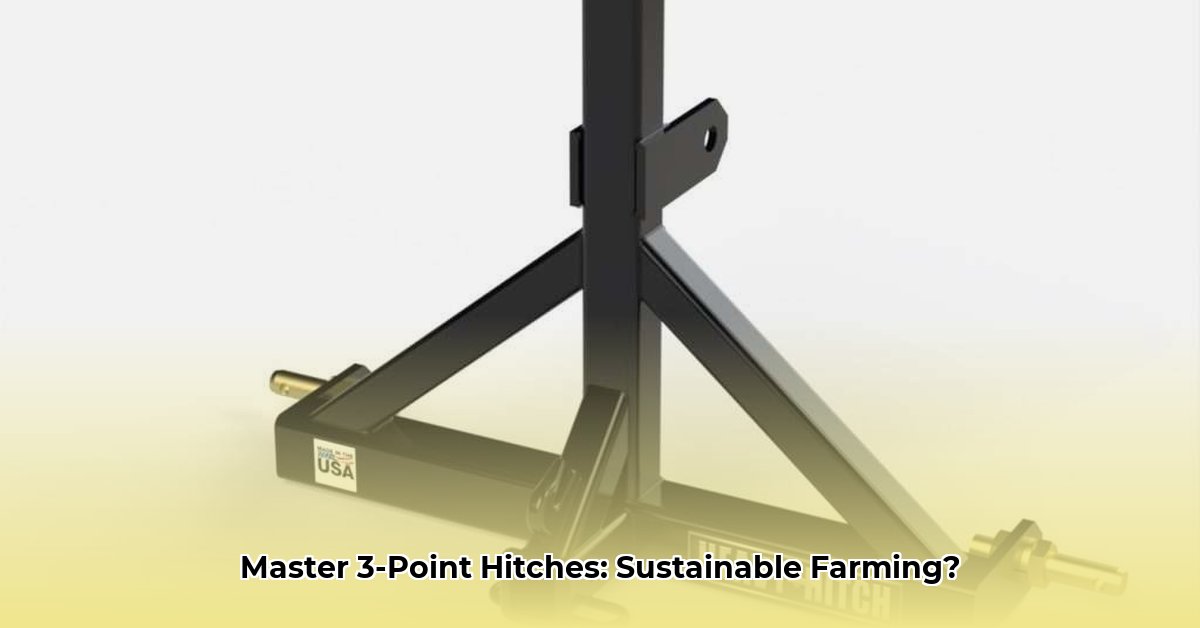
This comprehensive guide provides step-by-step instructions on choosing, installing, operating, and maintaining a 3-point hitch for your tractor, highlighting its crucial role in sustainable agriculture. Mastering this essential piece of equipment will significantly improve your farming efficiency and reduce your environmental footprint. For more information on trailer hitches, see this helpful resource.
Choosing the Right 3-Point Hitch
Selecting the appropriate 3-point hitch (a system connecting implements to a tractor's rear) is paramount for safety and efficiency. Overlooking crucial factors can lead to equipment damage and operational difficulties.
1. Tractor Compatibility: Always consult your tractor's owner's manual. It specifies the maximum weight capacity your tractor can safely lift. Exceeding this limit is extremely dangerous.
2. Implement Needs: Consider the types and weights of implements you'll use. Heavier implements require heavier-duty hitches with increased weight capacities. Category 1 hitches are typically for smaller tractors and lighter implements, while Category 2 is for larger, heavier equipment. Understanding these categories is vital for safe operation.
3. Hitch Specifications: Carefully examine the hitch's specifications, paying close attention to weight capacity, dimensions, and compatibility with your tractor's three-point linkage system. Ensure a precise match for safe and effective operation. Improperly sized hitches can be risky and inefficient.
Did you know that a properly matched hitch can increase implement efficiency by up to 15%, leading to fuel savings?
Installing and Setting Up Your 3-Point Hitch
Proper installation is crucial for safe and effective operation. Always perform these steps with the tractor engine off and parked on level ground.
Step 1: Aligning the Hitch: Carefully align the hitch's lower links with your tractor's lower lift arms. Precise alignment is key for a secure connection.
Step 2: Securing Lower Links: Insert the pins securely and use cotter pins or locking clips to prevent accidental disengagement. Double-check for firm fastening.
Step 3: Attaching the Top Link: Connect the top link to the tractor’s top hitch point. Adjust its length to ensure the hitch is level. An uneven hitch will create instability.
Step 4: Testing the Lift: Gently raise the hitch using your tractor's hydraulic lift. Listen for any unusual noises or binding.
Step 5: Final Inspection: Before attaching any implement, conduct a thorough visual inspection of all connections.
Operating Your 3-Point Hitch
Efficient and safe operation involves following these key steps:
1. Ground-Level Connection: Always lower the hitch to ground level before connecting or disconnecting implements. This minimizes risks and improves accessibility.
2. Secure Implement Attachment: Securely attach the implement, following the manufacturer's instructions. Never rely solely on the hitch to support heavy implements.
3. Hydraulic Lift: Use the tractor's hydraulics to raise the implement.
4. Disconnection Procedure: Always disconnect implements with the tractor on level ground and the implement properly supported.
Maintaining Your 3-Point Hitch
Regular maintenance is vital for longevity and preventing problems.
1. Regular Inspections: Regularly inspect all components for wear and tear, paying close attention to pins, links, and hydraulic lines.
2. Lubrication: Lubricate moving parts to ensure smooth operation. This reduces friction and extends the life of the components.
3. Tightening Connections: Tighten any loose connections, which ensures safe and reliable operation.
4. Addressing Issues Promptly: Address minor issues immediately to prevent bigger problems.
Sustainable Practices with 3-Point Hitches
Using a 3-point hitch allows for the use of implements that promote sustainable farming practices:
- No-till seeders: Reduce soil erosion and improve soil health.
- Precision fertilizer spreaders: Optimize nutrient use and minimize environmental impact.
- Cover crop seeders: Enhance soil quality and reduce erosion.
*Dr. Emily Carter, Agronomist at Cornell University, states: "Investing in precision agriculture tools is essential for reducing environmental impact and boosting farm profitability." *
Conclusion
Mastering your 3-point hitch is a cornerstone of efficient and sustainable farming. By adhering to this guide's instructions, you'll significantly enhance your operations while minimizing environmental impact. Remember that consistent maintenance, combined with the selection of appropriate implements, is key to achieving long-term success and sustainability.